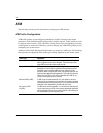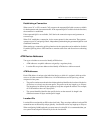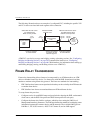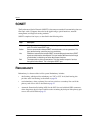
Chapter 3: Applications and Configuration Overview
Avidia System Configuration and Management User Manual 23
Establishing a Connection
When a new VC or VP is created, CAC compares the requested QoS with resources available
for both upstream and downstream traffic. If the requested QoS is available for both directions,
the connection is established.
If the requested QoS is not available, CAC denies the connection request and generates an
error message.
When CAC establishes a connection, it also creates queues for the connection. These queues
operate on a per-VC and per-QoS basis, independently maintaining the guaranteed QoS for each
established connection.
When setting up a connection, policing functions for the connection can be enabled or disabled.
If enabled, policing allows UPC functions to monitor traffic flow and discard non-conforming
cells.
ATM Device Addresses
Two types of addresses are used to identify ATM devices:
• ATM addresses are public addresses assigned by a regulatory body.
• Location IDs are private addresses that identify ATM devices within a network.
ATM Addresses
Each ATM address is unique to the individual device to which it is assigned, which provides
access to all other connected ATM devices. All ATM addresses are 20 bytes long, and are
composed of two parts:
• The prefix contains network and other information that identifies the location of the device.
All devices on a chassis use the same prefix. The prefix can be any length, up to 19 bytes.
The length may be defined by the regulatory body that assigned the address. For example,
all E.164 addresses have an 8-byte prefix.
• The system identifier identifies the specific device on the network. Its length is the
difference between 20 bytes and the prefix length.
Location IDs
Location IDs are assigned by an ISP or other local body. They are unique within a location ATM
network but are not necessarily unique globally. Location IDs can be any length up to 20 bytes.
When configuring OAM loopbacks you must enter a location ID. It is recommended that you
use system's network prefix followed by 0s for the Location ID.


















